Ijraset Journal For Research in Applied Science and Engineering Technology
- Home / Ijraset
- On This Page
- Abstract
- Introduction
- Conclusion
- References
- Copyright
Study on Use of Various Type of Warm Mix Asphalt (WMA) Additive’s in Asphalt Binder
Authors: Khombare Saurabh Mahavir, Pujari Amrut Vinayak, Chendke Sudesh Kumar, Mulla Mohammadmaruf Shakil, M. Shah , Patil Yashdutt Pradeep
DOI Link: https://doi.org/10.22214/ijraset.2023.54051
Certificate: View Certificate
Abstract
Recent years have seen a substantial increase in interest in warm mix asphalt (WMA) technology as a sustainable substitute for traditional hot mix asphalt (HMA) production. There are many benefits to adding warm mix asphalt additives to the asphalt binder, including less energy use, lower emissions, better workability, and longer pavement life. According to studies, the rheological and mechanical characteristics of the asphalt binder are significantly impacted by the use of warm mix asphalt additives. These additions often reduced the viscosity of the binder, improved workability, and increased rutting resistance. Additionally, the use of particular warm mix asphalt additives showed improved fatigue resistance and moisture resistance, making them ideal candidates forlong-lasting and sustainable paving.
Introduction
I. INTRODUCTION
Asphalt, a dark-colored or dark-brown substance resembling petroleum that can range in consistency from a viscous liquid to a glassy solid. It is either extracted from natural sources or leftovers from the distillation of petroleum. Warm Mix Asphalt is produced and mixed at temperatures roughly between 100 and 120°C. Hot Mix Asphalt is produced and mixed at temperatures roughly between 140 and 160 °C.Warm mix asphalt (WMA) is a new way of energy saving and environmental protection material with relatively low mixing and compaction temperatures and relatively small energy consumption and exhaust emission compared with the traditional hot mix asphalt.
Evotherm was invented by MeadWestvaco Asphalt Innovations in the United States in 2003 and currently owned by Ingevity. Evotherm has evolved from water-based package (Evotherm ET). Itis one of the chemical warm mix asphalt (WMA) technologies that has been widely used in sustainable asphalt pavement construction. But the long-term performance of such warm mix asphalt pavement has not been studied comprehensively.This study investigated the field-aged asphalt binder performance with three different Evotherm additives (ET, DAT and 3G) based on fourteen field projects across the United States. Their performance was compared with corresponding HMA control binder.
Sasobit is an organic warm binder additive with the Chemical Abstract Service (CAS) registration number 8002-74-2 and the chemical formula CnH2n+2 . Sasol Wax manufactures Sasobit in South Africa. It is a long chain of aliphatic hydrocarbons produced by coal gasification, a process that involves blasting white- hot hard coal or coke with steam using the Fischer-Tropsch method. Sasobit decreases the non-recoverable compliance (Jnr), penetration number, and Fraass breaking point regardless of the source of the binder while increasing the complex shear modulus (G) and maximum force of ductility of the asphalt binder at medium-sweep temperatures.
A. Problem Statement / need of study
- Hot mix asphalt is the most expensive of asphalt paving option.
- Hot mix asphalt should only be installed when the exterior temperature is 40 degrees or more, Hot mix asphalt can be used in cold whether state but it requires more energy. Low density polyethylene modified asphalt can be chemically and physically treated to increase its anti- cracking properties.
- The immediate benefit of Warm mix asphalt production is the reduction energy consumption required by fuel combustion to heat hot mix asphalt. WMA does not harm the properties of asphalt.
B. Research Gap
- Hot mix asphalt is the most expensive of asphalt paving option.
- Hot mix asphalt should only be installed when the exterior temperature is 40 degrees or more, Hot mix asphalt can be used in cold whether state but it requires more energy. Low density polyethylene modified asphalt can be chemically and physically treated to increase its anti- cracking properties.
- The immediate benefit of Warm mix asphalt production is the reduction energy consumption required by fuel combustion to heat hot mix asphalt. WMA does not harm the properties of asphalt.
C. Objectives Of Study
- To conduct conventional testing for asphalt binders like Penetration test, Ductility test, Softening point test, Viscosity test.
- To conduct the characterization of polymer-modified asphalt binders with the help of SEM Analysis and FTIR Test.
- To observe the rutting analysis of modified Asphalt binder.
- Enhance the mechanical qualities of asphalt binder and to improve asphalt performance.
- To perform a laboratory study to determine the applicability of additives (Sasobit ,Evotherm, Rediset ) in warm mix asphalt application including typical paving operation.
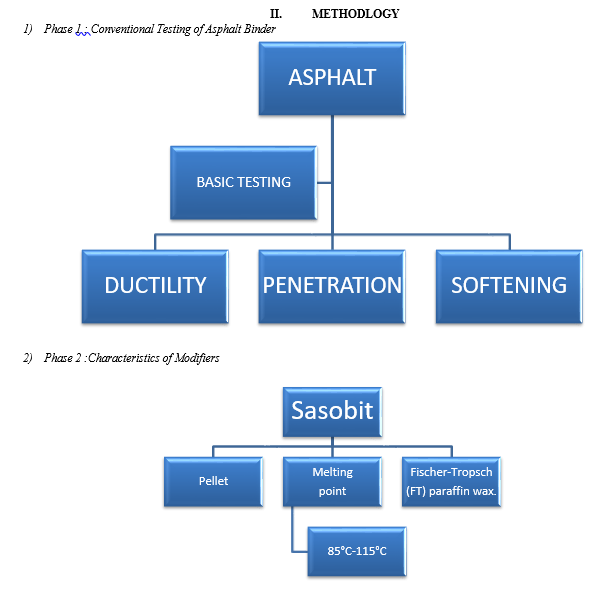
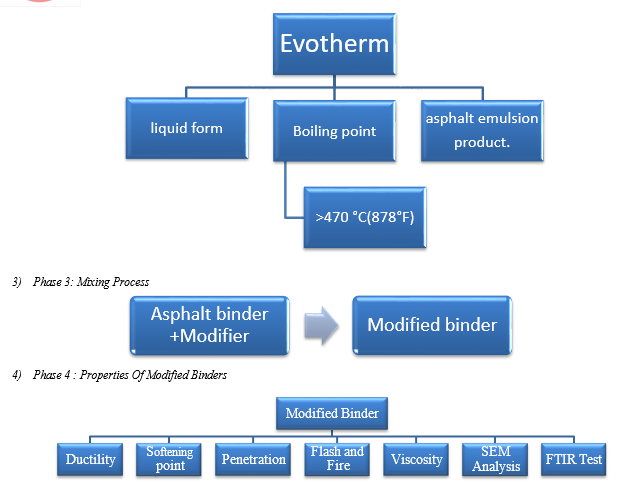
III. RESULTS AND DISCUSSION
A. Ductility Test of Bitumen
Apparatus Required
The equipment is comprised of the following:
- Briquette Mould: The material is brass. In order to hold the testing machine's fixed and moveable ends, circular holes known as clips are supplied at the ends. When properly put together, the mould creates a briquette specimen with the following dimensions:
- Total length 75.0 ± 0.5 mm
- Distance between clips 30.0 ± 0.3mm
- Width at mount of slip 20.0 ± 0.2mm
- Width at minimum cross-section (half way between clips) 10.0 ± 0.1mm
- Thickness throughout 10.0 ± 0.1mm
2. .Water Bath: A bath maintained at 27.0° 0.1°C below the designated test temperature, holding at least 10 litres of water, the specimen supported on a perforated shell, submerged to a depth of at least 10 cm, and less than 5 cm from the bath's bottom.
3. Testing Device: Any device that is designed to keep the specimen constantly submerged in water while the two clips are being pushed apart horizontally at a constant speed of 50 2.5 mm per minute may be used to separate the bituminous material briquette.
4. Thermometer: Readable up to 0.2°C and with a range of 0-44°C.
Procedure
a. Reheat the water bath at 27 °C for 85–95 minutes while placing the brass plate and mould containing the specimen inside.
b. Unscrew the clamps, remove the sides of the briquette mould, and remove the briquette from the base plate.
c. With the aid of the rings of the clips, attach the bitumen sample assembly and base plate to the pins or hooks in the ductility machine. One clip of the mould is attached to the moving part of the ductility machine, and the other clip is attached to the stationary part.
d. With the use of a screwdriver, tighten the screw on the mould's clasp.
e. Verify that the ductility machine's pointer is set to zero. (Or write down the ductility machine's initial reading).
f. The moveable portion should travel at a speed of 50 mm per minute once the ductility machine is turned on and the gear is adjusted. (The machine's pull rate must be maintained at 50 mm per minute).
g. As a result, the two clips are slowly but steadily drawn apart until the briquette specimen ruptures.
h. When the specimen ruptures, measure the space between the clips.
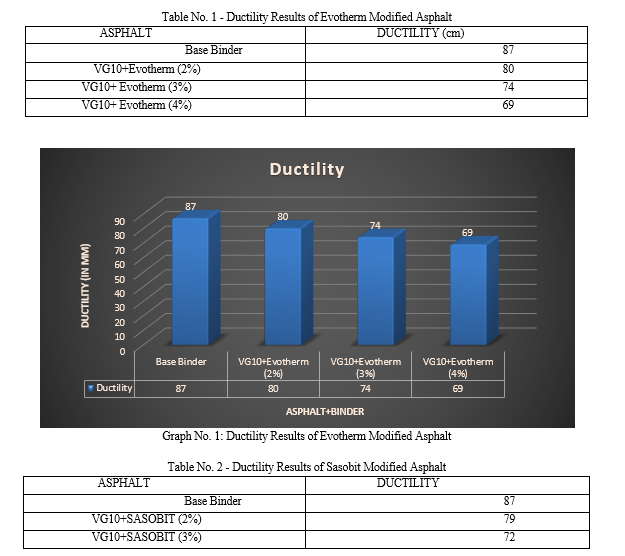
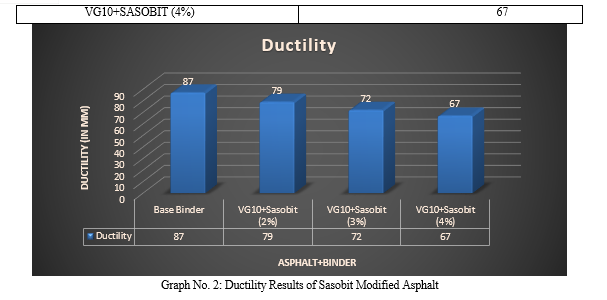
B. Penetration Test on Bitumen
Apparatus Required
- Penetrometer – Contains a knob to release the weight carrier, a graduated scale (1 in 10mm), and a 100g penetration carrier. a spirit level at the bottom to keep the surface level.
- Penetration Needle – Stainless Steel needle (SS316)
- Sample Container – 55mm dia & 35mm Depth
- Water bath – It should contain 10 litres of water & maintain at 25°C.
- Stopwatch – 1/10 seconds or Automatic penetrometer timer
- Transfer Tray – To immerse the sample container into the water.
- Thermometer – 0 to 44°C
Procedure
- Once the bitumen has reached the necessary melting temperature, pour it into the container and let it cool naturally for up to an hour.
- Now turn on the water bath, set the temperature to 25°C, and fill the transfer tray with water.
- The sample container should then be submerged in the transfer tray and placed there for up to two hours in the water bath.
- Place the container now on top of the penetrometer's base. The steel needle must then be cleaned with benzene and attached to the weight carrier.
- The needle should first make contact with the bitumen's top surface before beginning the penetration. It can be done using the penetrometer's adjustment screw.
- Take the G1 reading on the graded scale as your initial reading.
- 5 seconds after turning on the automated timer Currently, the needle gently penetrates the bitumen and automatically stops after 5 seconds.
- Take the graded scale's final reading, now.
Table No. 3 – Penetration test Results of Evotherm Modified Asphalt
|
ASPHALT |
PENETRATION (mm) |
|
Base Binder |
85 |
|
VG10+Evotherm (2%) |
79 |
|
VG10+Evotherm (3%) |
77 |
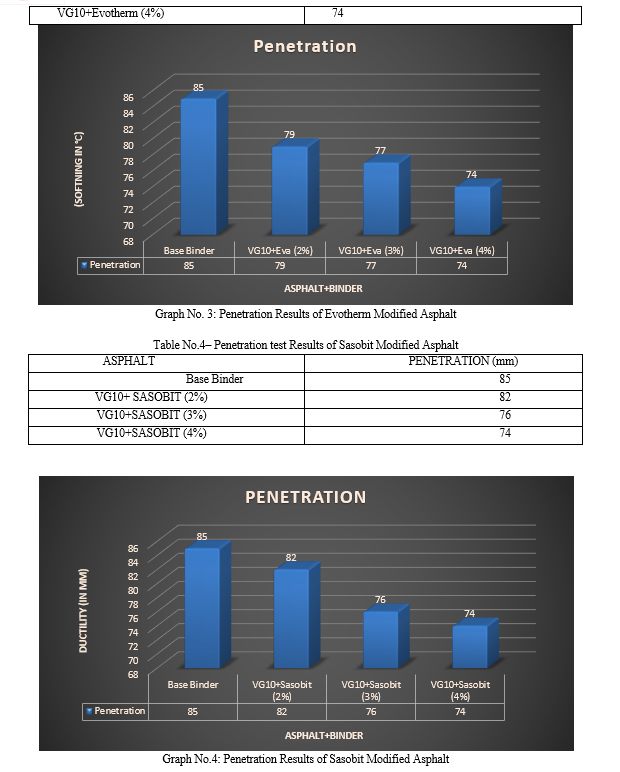
C. Softening Point Test
Apparatus Required
- Thermometer – To measure up to 120°c and an accuracy of 0.5°c.
- Steel ball 2 numbers – 7.5mm diameter & weight – 3.5 grams
- Brass ring 2 Numbers – Depth is 6.4mm & inner diameter for top – 17.5 mm & inner diameter for bottom – 15.9mm
- Ball frame / Ball guide 2 numbers – to resist the steel ball movement & hold it in position. The ball guide & the ring can fit each other and should be placed in the middle of the metal plate frame.
- Heat Resistant Beaker – Capacity of 600ml (85mm inner dia & 120mm Depth)
- The Metal Frame Consists OF 3 PLATE – The top plate has a hole to insert the thermometer. The middle plate has 2 slots to place the ring. The distance between the middle & bottom plate is 25 mm.
- Hot Plate – It is connected to the energy regulator, which can control the rate of heat production.
- Stirrer – Distribute the uniform temperature in the beaker.
- Distilled water
Procedure
a. Fill the beaker with the distilled water, making sure that the water level reaches the metal frame's middle plate.
b. Now use the ball guide to fix and tighten the ring. It needs to go in the slot on the middle palate that is supplied for it.
c. Place the steel ball over the ball guide after cooling it to 5 °C. Place the metal frame into the beaker right now.
d. Through the top plate's central hole, insert the thermometer.
e. Fixing the stirrer now entails turning on the hot plate. Inside the beaker, the temperature rises steadily at a rate of 5 °C each minute. Make sure the beaker is heated evenly.
f. At a certain temperature, the bitumen will melt, and the steel ball will drop to the bottom plate along with it.
g. ake note of the temperatures of the two balls as they descend to the bottom plate.
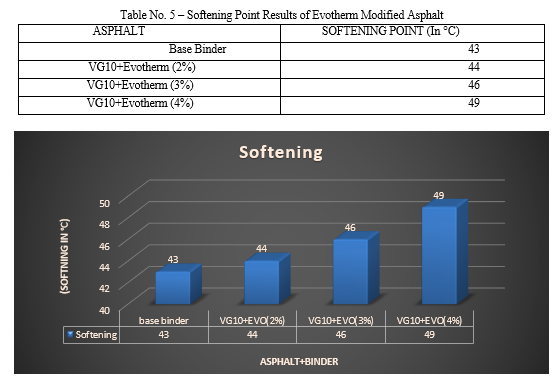
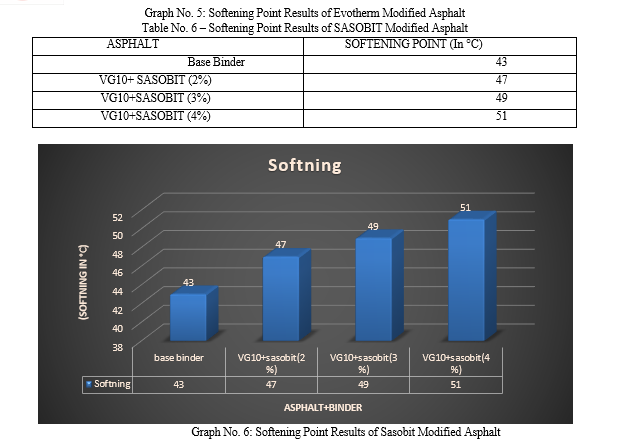
D. Fourier Transform Infrared (FTIR)
Apparatus Required
- FTIR Spectrometer: This is the primary instrument used for the analysis. It consists of a light source, an interferometer, a sample compartment, and a detector.
- Sample Cells: These are containers used to hold the bitumen sample during analysis. They should be transparent to infrared light, such as quartz or polyethylene.
- Software: FTIR spectrometers are typically accompanied by software for instrument control, data acquisition, and spectral analysis.
- Reference Materials: These are samples of known composition used for calibration and verification purposes.
- Solvents: Sometimes, bitumen samples may require dissolution in a suitable solvent to obtain a uniform film for analysis.
Procedure
a. Sample Preparation: Before analysis, a bitumen sample that is solid may need to be melted at the proper temperature. In contrast, if the sample is a solution, it can be applied right away. In some circumstances, it can be necessary to prepare a thin film of the sample by distributing a little amount on an appropriate substrate.
b. Instrument Setup: Verify that the FTIR spectrometer is correctly configured and calibrated in accordance with the guidelines provided by the manufacturer. Optics alignment, selecting the proper settings (such resolution and scan range), and using reference materials to confirm the instrument's performance are all included in this.
c. Baseline Correction: It's important to create a baseline by scanning an empty sample cell or the solvent used (if appropriate) before measuring the sample. Any background interference in the system is accounted for by this.
d. Sample Measurement: Apply a thin coating to the substrate or put the bitumen sample in the sample cell. Place the sample cell into the sample compartment of the spectrometer with care. To avoid any air gaps or moisture interference, the sample cell should be completely sealed.
e. Spectrum Acquisition: Launch the spectrum acquisition using the FTIR spectrometer's software. An interferogram is typically created by scanning a range of infrared wavelengths and collecting the resulting data.
f. Data Processing: Fourier transformation is used to translate the obtained interferogram into a spectrum of absorbance versus wavelength or wavenumber. The obtained spectrum depicts the bitumen sample's molecular make-up.
g. Data Analysis: Examine the obtained spectra to find distinctive peaks and absorption bands that correspond to particular functional groups or molecular vibrations that are present in the bitumen. Identification and quantification can be aided by comparison with reference spectra or databases.
h. Interpretation: Explain the spectrum characteristics and connect them to the characteristics or components of the bitumen, such as the existence of particular chemicals, chemical linkages, or structural details.

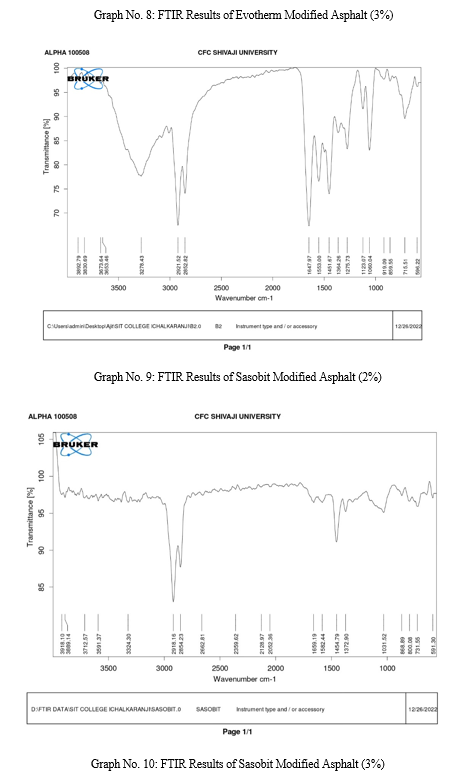 ???????
???????
Conclusion
1) Reduced Emissions: It has been shown that warm mix additives help to reduce emissions during the manufacture of asphalt. The generation of volatile organic compounds (VOCs) and other hazardous emissions linked to conventional hot mix asphalt processes is lessened by the lower mixing and compaction temperatures. 2) Energy Savings: Warm mix additives have the ability to lower the amount of energy needed to produce asphalt. These additives can reduce the energy required to heat the asphalt binder by lowering the mixing and compaction temperatures, resulting in energy savings and decreased greenhouse gas emissions. 3) Improve Conventional Properties: Compared to unmodified binders, asphalt modified binders often perform better. They frequently show improved resistance to ageing, thermal cracking, fatigue cracking, and rutting. Modifiers can improve the binder\'s resistance to the stresses and stretches encountered in the pavement construction. 4) Environmental Considerations: To lessen the influence of asphalt binders on the environment, researchers have been investigating environmentally friendly modifiers, such as bio-based additions or recycled materials. With these modifications, performance attributes are maintained or enhanced while sustainability is improved. 5) Enhanced Rheological Properties: Modifiers have a big impact on how rheologically stable asphalt binders are. They can lessen the likelihood of rutting by enhancing the binder\'s stiffness and elastic characteristics at high temperatures. Additionally, modifiers can improve the binder\'s low-temperature characteristics, strengthening its resistance to cracking in chilly environments.
References
[1] Performance of Warm Mix Asphalt containing Sasobit:State-of-the-art AliJamshidi MeorOthmanHamzah,ZhanpingYou http://dx.doi.org/10.1016/j.conbuildmat.2012.08.015 [2] The Role of additives in Warm Mix Asphalt Technology : An Insight into Their Mechanisms of Improving an Emerging Technology. PaolinoCaputo , Abraham A. Abe , Valeria Loise , Michele Porto , Pietro Calandra , Ruggero Angelico and Cesare Oliviero Rossi doi:10.3390/nano10061202 [3] EVALUATION OF SASOBIT FOR USE IN WARM MIX ASPHALT Graham C. Hurley Brian D. Prowell https://www.researchgate.net/publication/238068542 [4] Field-aged asphalt binder performance evaluation for Evotherm warm mix asphalt: Comparison with hot mix asphalt. ShenghuaWu, Weiguang Zhang, Shihui Shen, XiaojunLi, Balasingam Muhunthan, LouayN. Mohammad. http://dx.doi.org/10.1016/j.conbuildmat.2017.09.016 [5] Sasobit-Modified Asphalt Binder Rheology. Khalid A. Ghuzlan, Ph.D.; and Mohammad O. Al Assi. https://doi.org/10.1061/(ASCE)MT.1943-5533.0001996
Copyright
Copyright © 2023 Khombare Saurabh Mahavir, Pujari Amrut Vinayak, Chendke Sudesh Kumar, Mulla Mohammadmaruf Shakil, M. Shah , Patil Yashdutt Pradeep . This is an open access article distributed under the Creative Commons Attribution License, which permits unrestricted use, distribution, and reproduction in any medium, provided the original work is properly cited.

Download Paper
Paper Id : IJRASET54051
Publish Date : 2023-06-14
ISSN : 2321-9653
Publisher Name : IJRASET
DOI Link : Click Here
 Submit Paper Online
Submit Paper Online

